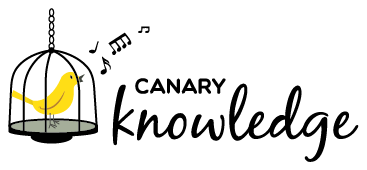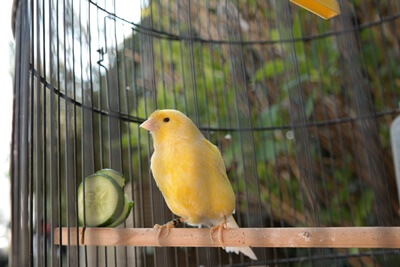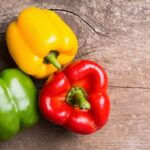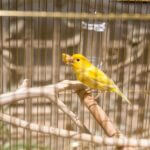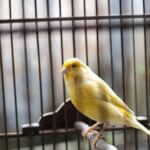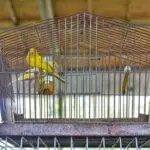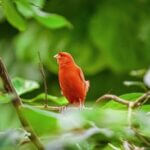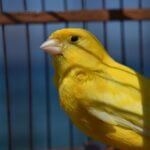From romaine lettuce to endive to corn, your canary will enjoy eating a wide variety of vegetables.
When picking vegetables for your canary, consider their taste, texture, and color. However, most importantly, examine the nutrient profile. After all, some vegetables are more nutritious than others.
Some vegetables should only be fed sparingly, especially those high in oxalates or from the nightshade family. They’re still safe and nutritious but should be consumed in moderation.
What Vegetables Can Canaries Eat?
Canaries can eat lots of vegetables, ranging from leafy greens to herbs to juicy roots.
The only vegetables to avoid or eat in moderation are those high in oxalates or from the nightshade family. Vegetables high in oxalates include:
- Rhubarb
- Beets
- Leeks
- Okra
Oxalates reduce nutrient absorption and lead to kidney stones. They’re safe for canaries to consume in moderation, but don’t offer them more than once per week.
Also, plants from the nightshade family, like tomatoes and eggplants, are safe to eat. However, don’t feed them other parts of the plant, as they’re toxic to canaries.
Do Canaries Need Vegetables?
Canaries are granivores, which means that their diet is mostly comprised of seeds and grains. However, wild canaries still eat vegetables.
Ideally, canaries should eat more greens than fruits, as fruit contains more sugar. An ideal canary’s diet should consist of 20-25% fruits and vegetables.
Vegetables To Feed Canaries
Here’s an assessment of the different vegetables fed to canaries:
Red Cabbage
Cabbages are believed to have been introduced to Europe by the Celts. Its scientific name, Brassica, comes from the Celtic word ‘bresic,’ which means ‘cabbage.’
There are two main kinds of cabbages, namely green and red cabbage. Green cabbage is nutritious but isn’t the best choice as it contains oxalic acid.
Red cabbage is more nutritious, containing 10 times more vitamin A than green cabbage.
Red cabbage does contain less vitamin K, which is needed for bone health. However, it has more iron and vitamin C. The nutrients in 1 cup of red cabbage include:
- Calories: 22
- Protein: 1 gram
- Fat: 0.1 gram
- Carbohydrates: 5 grams
- Fiber: 2 grams
- Sugar: 2.8 grams
- Calcium: 40 mg
- Magnesium: 14.2 mg
- Phosphorus: 26.7 mg
- Potassium: 216 mg
Despite these nutrients, it’s still best to feed cabbage sparingly.
Brussels Sprouts
Brussel sprouts supposedly took their name from where they originated in Brussels, Belgium. In this area, they have been traced back to the 13th century.
Brussels sprouts look like mini cabbages, and their small size and crunchy texture make them great candidates for your canary’s favorite snack.
Despite their size, brussels sprouts are full of nutrients. In 1 cup of brussels sprouts, nutrients include:
- Vitamin C: 74.8
- Thiamin: 0.1 mg
- Riboflavin: 0.1 mg
- Niacin: 0.7 mg
- Vitamin B6: 0.2 mg
- Calcium: 37 mg
- Magnesium: 20.2 mg
- Phosphorus: 60.7 mg
- Potassium: 342 mg
Spinach
Spinach originated more than 2,000 years ago in ancient Persia (Iran).
It’s a popular vegetable. In 1 cup of spinach, you will find:
- Vitamin C: 8.4 mg
- Vitamin K: 145 mcg
- Calcium: 29.7 mg
- Magnesium: 23.7 mg
- Phosphorus: 14.7 mg
- Potassium: 167 mg
Moreover, spinach is also rich in various antioxidant plant compounds, including lutein and zeaxanthin.
Spinach should be fed less than other canary-safe vegetables because it contains a significant amount of oxalates.
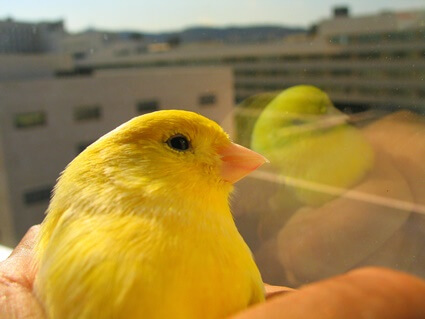
Watercress
Watercress, a member of the mustard family, originates back in Ancient Greece.
It’s considered one of the most nutrient-dense foods and is ranked number 1 on the CDC’s Powerhouse Fruits and Vegetables list. The nutrients in 1 cup of watercress include:
- Vitamin C: 14.6mg
- Calcium: 40.8 mg
- Phosphorus: 20.4 mg
- Potassium: 112.2 mg
Watercress has small leaves that will be fun for your canary to eat.
Swiss Chard
It’s called Swiss chard because it got its scientific name from the Swiss botanist, Karl Heinrich Emil Koch.
Swiss chard belongs to the same family as amaranth, beets, spinach, and quinoa. Like the rest of its family, Swiss chard is also rich in vitamins and minerals. These include:
- Calcium: 18 mg
- Iron: 0.65 mg
- Magnesium: 29 mg
- Phosphorus: 17 mg
- Potassium: 136 mg
- Vitamin c: 10.7 mg
- Vitamin A: 110 mcg
- Vitamin E: 0.68 mg
- Vitamin K: 298 mcg
- Folate: 5 mcg
More importantly, it contains various antioxidants, like lutein and zeaxanthin. This also includes the antioxidant beta carotene, which gives canaries a brighter color.
Chard also has an interesting texture, as its leaves are wide and crinkly. You can pick from different stem colors, like pink, yellow, or white, for added variety.
Kale
Often touted as a super-food, kale is among the most nutritionally dense vegetables. Kale is rich in various nutrients, including:
- Vitamin C: 14.6mg
- Vitamin K: 85mcg
- Vitamin A: 54.4mcg
Notably, it contains a little fat, but most of it is omega-3 fatty acids. Omega-3 has been linked to lower levels of atherosclerosis, which is common in captive birds.
Even better, kale is rich in beta carotene, which is often found in plants that are yellow or orange.
Bok Choy
Bok choy can be dated back to 400 AD and remains popular today. In Singapore, bok choy is farmed in vertical growers that reach 30 feet tall.
Also known as Chinese cabbage, bok choy is called pak choi, or pok choi. One cup of bok choy contains:
- Calcium: 74 mg
- Iron: 0.56 mg
- Magnesium: 13 mg
- Phosphorus: 26 mg
- Potassium: 176 mg
- Zinc: 0.13 mg
- Folate: 46 mcg
- Vitamin A: 156 mcg
- Vitamin K: 31.9 mcg
Bok choy has wide leaves with rounded edges. The leaves are nestled against each other, tapering into the center and then outward at the bottom. As a whole, it’s shaped like a vase or an hourglass.
This interesting shape makes it a great alternative to red and green cabbages. Add bok choy to your canary’s chop for added variety.
Lettuce
Lettuce has been cultivated for many years. You can even see lettuce depicted in Ancient Egyptian tombs dating back to at least 2,700 BC.
Today, there are many types of lettuce, including iceberg lettuce. However, it’s not the best choice for your canary due to the lack of nutrients.
An alternative is romaine lettuce, which contains just as much water as iceberg lettuce, but more nutrients in almost every category. In 1 cup of lettuce, you will find:
- Calcium: 43.4 mg
- Iron: 0.6 mg
- Magnesium: 14 mg
- Phosphorus: 24.5 mg
- Potassium: 229 mg
- Sodium: 17.5 mg
- Folate: 90.3 mcg
- Vitamin A: 194 mcg
- Vitamin C: 8.1 mg
Notably, romaine lettuce contains 2,320 mcg of beta-carotene, which gives canaries brighter feathers.
Alternatives to romaine lettuce are:
- Butterhead lettuce
- Belgian endive
- Curly endive
- Arugula
Switching between these variations is a good idea to keep your canary’s diet novel. Each variety has its own taste, smell, and texture, which can be enriching for your canary.
Microgreens
Microgreens aren’t technically a leafy green but the immature version of leafy greens. Microgreens are harvested about 1-2 weeks after sprouting. You’ll usually see microgreens as a garnish on food.
The nutrients found in microgreens depend on the vegetable. However, according to the Journal of Agricultural Food Chemistry, microgreens can be 40 times more nutritious than the grown plant.
Microgreens are a great source of the following nutrients:
- Vitamin A
- Vitamin C
- Vitamin E
- Vitamin K
Microgreens can be harvested from many common vegetables. You can even create microgreens yourself by sprouting seeds in your home. Common microgreens are harvested from:
- Celery
- Cauliflower
- Broccoli
- Cabbage
- Chicory
- Dill
- Carrot
Dandelion
Dandelions are often thought of as a weed. However, dandelions have been considered a medicinal plant, dating back to Ancient Egypt.
Dandelions are believed to have been brought on the Mayflower. Unlike many other plants, dandelions were brought over intentionally due to their medicinal properties.
Dandelions contain the following nutrients:
- Vitamin K: 428.1mcg
- Iron: 1.7mg
- Vitamin A: 279.4mcg
Dandelions are a common snack for birds, like canaries. They’re nutritious, easy to find, and can be safely fed in large amounts.
All parts of the dandelion, including the flower, are safe for your canary to eat.
Broccoli
Broccoli comes from the Latin’ brachium,’ which means ‘arm, branch, or sprout.’ Broccoli can be traced back to the Etruscans. Broccoli would first find its way outside of Italy in 1533 due to none other than Catherine de Medici, who introduced the vegetable to the French court.
At first, broccoli had a stale reception because of its sulfurous scent while cooking. But in the modern-day, it is one of the most common vegetables worldwide.
One cup of raw broccoli includes:
- Vitamin C: 81.2 mg
- Choline: 17 mg
- Calcium: 42.77 mg
- Magnesium: 19.11 mg
- Phosphorus: 60 mg
- Potassium: 287.56 mg
There are at least 30 varieties of broccoli; switch up the variety to keep your canary interested.
Cauliflower
Cauliflower resembles broccoli, but its head remains white because the leaves protect the head from the sun, allowing it to retain its white color. However, cauliflower comes in other colors, including purple.
Cauliflowers are good for canaries because of their nutritional profile. One cup of cauliflower includes:
- Vitamin C: 46.4 mg
- Choline: 45.2 mg
- Calcium: 22 mg
- Magnesium: 15 mg
- Phosphorus: 44 mg
- Potassium: 303 mg
Cauliflower is also rich in various antioxidants. Of these antioxidants, the most interesting one is sulforaphane, a widely studied antioxidant.
According to Cancer Letters, sulforaphane has anti-cancer properties for many cancers.
When feeling cauliflower, include the leaves for your canary. The leaves have a stronger taste than the florets, which your canary might like.
Red Peppers
Red peppers come from the same family as all other hot chili peppers. Of all the varieties, bell peppers are the only ones that don’t contain capsaicin, which gives peppers their spice. Because of this, bell peppers are sometimes called sweet peppers.
In 1 cup of red peppers, you will find the following nutrients:
- Vitamin A: 4666 IU
- Vitamin C: 190 mg
- Vitamin E: 2.4 mg
- Thiamin: 0.1 mg
- Riboflavin: 0.1 mg
- Niacin: 1.5 mg
- Vitamin B6: 0.4 mg
- Folate: 68.5 mcg
Of all the peppers, red peppers are the most nutritious. However, green and yellow bell peppers are also rich in vitamins and make great alternatives.
Red peppers have all the factors that canaries like: crunchy texture, sweet taste, and bright color.
Feel free to give your canary the entire vegetable, including the seeds. The seeds are perfectly safe to eat, and your canary will love munching on them, too.
Chili Peppers
Peppers are great for your canary, even spicy ones, as they can’t taste the spice in chili peppers. According to Cell, birds help distribute chili pepper seeds through their poop.
In 45 g of chili peppers, you’ll find:
- Vitamin A: 428 IU
- Vitamin C: 64.7 mg
- Vitamin K: 6.3 mcg
- Niacin: 0.6 mg
- Vitamin B6: 0.2 mg
- Folate: 10.4 mcg
- Choline: 4.9 mg
Notably, the same serving of red chili peppers also contains compounds that can help with a canary’s bright yellow color. In 45 g of red chili peppers, these compounds are:
- Lutein and zeaxanthin: 319 mcg
- Beta carotene: 240 mcg
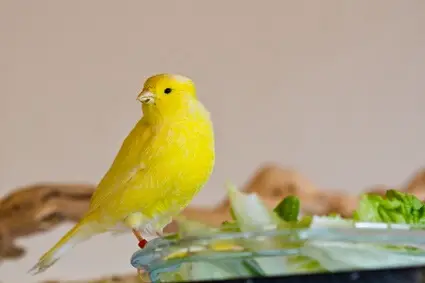
Peas
Scientists determined that the plant can be dated back to the Neolithic period.
Canaries love picking out these small green veggies, especially from the pod.
All types of peas are safe for your canary to eat. There are three main types you can choose from:
- Garden, green, or English peas
- Snow peas
- Snap peas or sugar snap peas
Snow peas and sugar snap peas have the same nutritional profile. One cup contains:
- Vitamin A: 1065 IU
- Vitamin C: 58.8 mg
- Calcium: 42.1 mg
- Magnesium: 23.5 mg
- Phosphorus: 51.9 mg
- Potassium: 196 mg
Carrots
There was a time in history when carrots were used as medicine, as evidenced by seeds found in archeological digs. It wasn’t until the 13th century that the carrot’s root was cultivated as food.
Carrots are good vegetables for your canary, as they’re crunchy, sweet, and full of vitamins and minerals. The nutrients found in 1 cup of raw carrots include:
- Vitamin C: 7.2 mg
- Choline: 10.7 mg
- Calcium: 40.3 mg
- Phosphorus: 42.7 mg
- Potassium: 390 mg
Carrots are rich in beta and alpha-carotene. A cup contains 10,108 mcg f beta carotene and 4,242 mcg of alpha-carotene. These compounds are carotenoids, giving a canary a more vibrant color.
A good variety to consider is purple carrots because they contain more antioxidants.
Corn
The domestication of corn dates back 10,000 years to the native peoples in southern Mexico. Today, corn is one of the most widely cultivated vegetables grown on every continent except Antarctica.
Corn can be served on and off the cob. Corn on the cob can be more enriching since your canary can pick out each kernel, but it can be messy. One cup of raw sweet corn contains:
- Vitamin A: 288 IU
- Vitamin C: 10.5 mg
- Calcium: 3.1 mg
- Magnesium: 57 mg
- Phosphorus: 137 mg
- Potassium: 416 mg
You can also give popcorn to a canary without oil or seasoning.
Corn also comes in different colors like white, orange, and purple.
